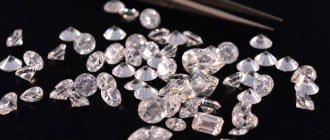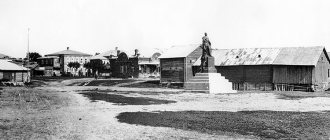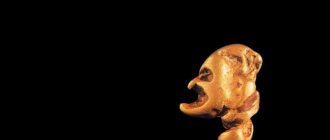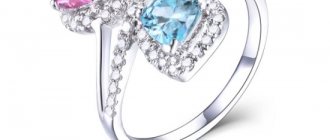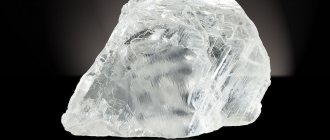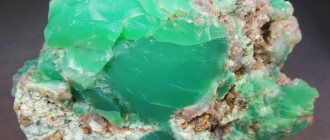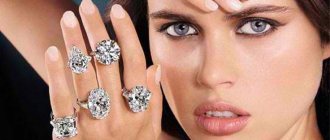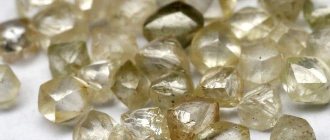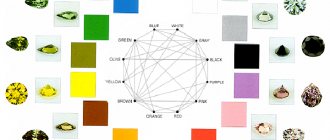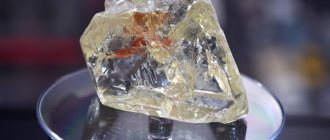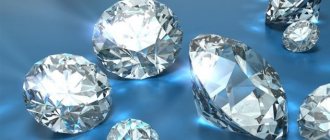Author: stabskapitan
31 January 2021 21:34
Tags: interesting to know history facts
8183
15
"Cumlinan", "Cullinan" (or "Star of Africa") is the largest diamond in the world. Its weight was 3106.75 carats (621.35 grams), dimensions 100x65x50 mm.
0
See all photos in the gallery
copy diamond
The famous diamond was found by accident. Fortune fell on the Premier mine in the Transvaal, near the city of Pretoria in what is now South Africa. On January 25, 1905, mine manager Frederick Wells made his nightly inspection of the mine. When he descended to a depth of five meters, in the reflections of the setting sun in the wall above his head, he noticed a flash of light. At first, Frederick thought that one of the miners was joking and stuck a piece of glass into the wall of the mine. However, he still came closer and, using a pocketknife, extracted from the rock a crystal about ten centimeters long, six centimeters wide and seven centimeters high.
0
Experts soon discovered an interesting feature of the shape and structure of its crystal. It turned out that Cullinan was part of a much larger stone. Once upon a time, nature split a huge diamond, and most of it remains unfound. The discovery of the world's largest diamond became a real sensation. It not only aroused public interest, but also gave a powerful impetus to the development of the diamond mining industry. Particularly exciting was the fact that part of the diamond from which Cullinan had broken off still remained in the ground. Mine manager Frederick Wells received £3,500 for the find. The diamond itself was purchased from Sir Thomas Cullinan by the Transvaal government for £150,000. On the initiative of the Prime Minister of the Transvaal, General Louis Botha, it was decided to give the diamond to the English King Edward VII in honor of his 66th birthday. Thus, the country intended to express gratitude to him for recognizing the constitution of the Transvaal, the territory of which became part of the British Empire in 1902 as a result of the Boer War. The decision to give Cullinan to the King of England was made by vote. Oddly enough, the majority of the Boers supported this decision, while the English part of the country's population, on the contrary, was against it. The final word remained with the king himself - whether to accept the gift or not. A significant role in Edward VII's decision to accept the stone was played by the future Prime Minister of England Winston Churchill, who actively advocated showing mercy to the Boers defeated in the war.
0
In 1905, Cullinan had to be transported to England for ceremonial presentation to the king. Unprecedented security measures were taken to ensure the safety of the cargo. Several detectives from Scotland Yard arrived especially from London. In addition, additional security guards were hired. The diamond was loaded with honors onto a ship bound for Great Britain. However, upon arrival at the place, the priceless stone was not there. The fact is that the noisy and public dispatch was just a distraction. Instead of the diamond, a copy of it was brought to the ship under guard. It was decided to send the real Cullinan in a different way. As a result, he arrived safely in England... via an ordinary registered postal parcel. One can only envy the steely nerves of the British of that time, as well as their absolute faith in Royal Mail - the Royal Mail of England. In November 1907, the world's largest diamond was presented to King Edward VII of Great Britain on his 66th birthday. At a gala reception in the presence of guests and royalty from other countries, the Secretary of State, on behalf of the monarch, announced that he was receiving it “for himself and his successors.” There was also a guarantee that “this great and unique diamond will be kept and protected among the rest of the historical stones that make up the heritage of the crown.”
0
With the approval of the king, the cutting of the diamond was entrusted to the famous Amsterdam company IJ Asscher & Co. The company of hereditary cutters, the Aschers, became famous for being the first to patent the original “Asscher” cut in 1902, which is now classified as a classic cut. In addition, the Dutch company in 1903 successfully cut the Excelsior diamond, the largest in the world before the Cullinan. Josef Ascher studied the unique diamond for several months before making a barely noticeable scratch on it. After this, in the presence of several famous jewelers, in the midst of solemn silence, Asher put a chisel to a scratch on the diamond, hit it with a hammer and lost consciousness. But the calculation turned out to be correct. Having regained consciousness, Asher repeated this operation several more times on the fragments of the Cullinan diamond that had arisen from the first blow. As a result of cutting and polishing, nine large diamonds of exceptional quality and 96 small ones were born. The largest of the nine diamonds was called Cullinan I, the smallest, respectively, Cullinan IX. Mentions of the first two of these nine famous diamonds can be found in our specially prepared Table of the Largest Diamonds in the World.
0
0
0
Cullinan I
The Cullinan I or "Great Star of Africa" is the largest of all the diamonds produced by cutting the Cullinan diamond. It weighs 530.20 carats and is pear-shaped with 76 facets. By order of King Edward VII, the diamond was mounted in the top of the royal scepter, which is currently on display in the Tower of London.
0
Rating of the largest diamonds found in Russia
There are many huge diamonds mined in Russia. Most of the minerals are mined in Yakutia. Moreover, 20% of the income from the sale of crystals goes to the development of the region.
Outstanding stones in the world and in Russia include:
- XXVI Congress of the CPSU. This stone was mined in 1980 - before the CPSU Congress. What weight did the mineral have? It reaches 342.57 carats. The gem is characterized by a lemon-yellow hue.
- Creator. This gem was found in Yakutia relatively recently - in 2004. Its weight reached 298.48 carats. In 2006, the crystal was secretly delivered to Moscow.
- Alexander Pushkin. The stone was mined in 1989. Initially it was called the “Indestructible Soviet Union”. But after cracks were discovered in the structure of the gem, it was canceled. The second title was dedicated to the poet’s anniversary.
- Free Russia. The mineral was found in Yakutia in 1991. Its weight was 241.88 carats. The name of the crystal was dedicated to Russian Independence Day. The gem was presented to then President Boris Yeltsin. This happened after the signing of a Decree, according to which 20% of the income from the sale of crystals will be directed to the development of Yakutia.
- City of Vilyuisk. The gem was found in 2013. Its weight was 235.16 carats. It is a transparent crystal of yellowish color. The mineral is characterized by an octahedral shape. The structure contains graphite-sulfide elements. Its cost is 1.5-2 million dollars. The crystal was divided into 10 elements. The largest was the “Star of Vilyuysk”. In 2021, the crystal was sold at auction.
Note! Many of these stones are kept in the Diamond Fund or in private collections. At the same time, it is difficult to name the cost of gems, but it can be estimated at tens of millions of dollars. .
Cullinan II
The Cullinan II or "Little Star of Africa", the second largest of the Cullinan diamonds, weighs 317.4 carats and is cushion cut. It ranks fifth among the largest diamonds in the world. Cullinan II is set on the rim of the Crown of the British Empire, along with such famous stones as the St Edward's sapphire, the Stuart sapphire and the Black Prince ruby. The crown, along with other royal treasures, is on display in the Tower of London.
0
The largest diamonds in the world. Top 10
>
Updated 01/05/13 22:10
:
Throughout human history, diamonds have been objects of universal admiration and attracted the special attention of noble people. As symbols of a certain status, they crowned the crowns of rulers or simply sparkled gracefully on the fingers of ladies, causing delight in those around them. Some diamonds are famous for their rich history, others are known for their fabulous prices, and others are famous throughout the world for their impressive sizes. It is the latter that we will talk about in this review. We present to your attention the ten largest diamonds in the world.
10th place: Millennium Star
– a colorless diamond weighing 203.04 carats (40.6 grams), cut into a pear shape with 54 facets. The internally and externally flawless stone is part of the “Millennium” jewelry collection owned by the De Beers company. The 777-carat diamond from which the Millennium Star was made was found in Mbuji-Mayi (Congo) in 1990. For more than three years, employees of the Steinmetz Diamond Group have been processing diamonds using laser technologies. First, it was split in Belgium, then polished in South Africa, and the final stage of processing took place in New York, where the official presentation of the finished Millennium Star diamond took place in 1999. In 2000, during a London exhibition at the Millennium Dome, an attempt was made to steal the Millennium Collection, but police discovered the plot and arrested the robbers before they escaped. The real value of the stone is still unknown, but it is insured for £100 million.
9th place: Red Cross
- a canary yellow cushion diamond weighing 205.07 carats (41 grams), discovered in one of the South African mines of the De Beers company in 1901. The net weight of the mined diamond was 375 carats. After cutting, the Red Cross acquired a mysterious detail - an eight-pointed Maltese cross is clearly visible through the upper edge, which is where its name comes from. Another distinctive feature of a diamond is its ability to store light and subsequently glow in the dark. In 1918, the stone was presented as a gift to the British Red Cross, which put the diamond up for auction at Christie's, where it was sold for 10 thousand pounds sterling. All proceeds from the auction were spent on medicines and hospital improvements. The Red Cross participated in auctions twice more - in 1973 and 1977. The identity of the stone's current owner remains unknown.
8th place: De Beers
- a pale yellow diamond weighing 234.65 carats (46.9 grams), found at the De Beers mine in Kimberley (South Africa) in 1888. Before cutting, the diamond, shaped like a crooked octahedron, weighed 428.50 carats. In 1921, the then ruling Maharaja of Patiala, Bhupindra Singh, purchased De Beers for his collection. Seven years later, in Paris, the Cartier jewelry house made the ceremonial “Patiala Necklace”, in the very center of which the De Beers diamond was installed. The necklace was set with 2,930 diamonds weighing a total of 962.25 carats. After the death of the Indian prince of Patiala, it disappeared. In 1998, pieces of the jewel began to appear on the London jewelery market, but seven stones ranging from 18 to 73 carats and the De Beers diamond were never discovered. Then the Cartier jewelry house bought all the remaining parts of the Patiala necklace and spent four years restoring it, installing artificial crystals instead of the missing originals.
Updated 01/05/13 22:10
:
7th place: Yubileiny / Jubilee
– a colorless diamond weighing 245.35 carats (49 grams), cut into a cushion shape. The large 650.80-carat diamond, discovered in 1895 at the Jagersfontein mine in South Africa, was originally named after William Francis Reitz, then President of the Orange Republic. The irregularly shaped gemstone was cut in 1897, on the “diamond” anniversary of the reign of Queen Victoria of Great Britain, after which it was named. In 1900, it was presented at the Paris Exhibition, where it attracted public attention. The first owner of the Jubilee diamond was the Indian businessman Dorabji Jamsetji Tata, who gave it to his wife. When the Indian industrialist died in 1932, his heirs decided to sell the diamond. “Yubileiny” changed owners several times. The last owner, Paul-Louis Veiller, purchased the gem for the Washington Museum at the Smithsonian Institution, where everyone can see it.
6th place: Centenary
– a unique flawlessly cut diamond weighing 273.85 carats (54.8 grams), owned by the largest diamond mining company De Beers. The 599-carat diamond, found in the South African diamond fields, was first unveiled to the public on the company's centenary in 1988. The processed stone was shown already in 1991. The unusual heart-shaped cut stone received the highest color group D and the highest clarity FI. According to experts, “Century” is the largest diamond with similar characteristics, which is what makes it unique. The diamond was loaned to the Tower of London, where it was displayed to the public for several years. There is information that in 2008, the De Beers company sold the stone to a wealthy entrepreneur from the United States, whose name remains unknown.
5th place: Spirit of de Grisogono
- the world's largest black diamond weighing 312.24 carats (62.4 grams). The stone, unique in its beauty and purity, was found in Central Africa and originally weighed 587 carats. Its first owner was the Swiss jeweler Fawaz Gruosi, a master of black diamond processing. He took the stone to Switzerland, where he cut it into a rose shape, an ancient cutting style developed in India. Now the Spirit of de Grisogono diamond is set in a white gold ring, inlaid with 702 small transparent diamonds weighing a total of 36.69 carats. The Swiss jeweler studied the diamond for over a year before giving it this beautiful shape, complementing the ancient rose cut with a modern design. The rare “Spirit of de Grisogono” diamond has been in several private collections, but it still belongs to the De Grisogono jewelry company.
4th place: Cullinan II / Cullinan II
- a colorless emerald-cut diamond weighing 317.4 carats (63.5 grams), the second largest diamond from the famous Cullinan diamond, the largest in the history of mankind. A giant crystal weighing 3,106 carats was discovered in the British colony of Transvaal, South Africa, in 1905. It was named in honor of Thomas Cullinan, the owner of the mine where it was found. The best cutter in Europe, Joseph Asher, who had the honor of processing a unique diamond, divided the Cullinan into 2 large, 7 medium and 96 small diamonds of exceptional purity. The Cullinan II diamond adorns the crown of the British Empire, which is on display at the Tower of London.
Updated 01/05/13 22:11
:
3rd place: Incomparable
is a 407.48-carat golden-yellow diamond whose unusual triangular shape gave rise to the term “triolet.” It was accidentally found in the early 1980s by a little girl near abandoned diamond mines in the city of Mbuji Maiv (Congo). The diamond originally weighed 890 carats. The Incomparable diamond was first put up for sale at Christie's in 1988, where it was purchased for $12 million by Theodore Horowitz from Geneva. In 2002, it ended up on the E-bay electronic auction, where its initial price was $15 million, which became a record for this type of auction, but no one responded to this offer. In 2009, Incomparable was exhibited at Canada's Royal Ontario Museum. In 2013, a unique golden-yellow diamond was set in a rose gold necklace set with 91 diamonds, which was prepared for it by Mouawad.
2nd place: Cullinan I / Cullinan I
or Great Star of Africa - a colorless diamond weighing 530.2 carats. It is the largest piece of the Cullinan diamond, discovered in 1905 in the English colony of Transvaal (South Africa). In 1907, the Transvaal government presented the diamond as a gift to the British King Edward VII on his 66th birthday. The work of cutting the diamond was entrusted to the famous Dutch jewelry house I. J. Ascher & Co. The stone of impeccable purity was cut in the form of “pandelkas” and received 74 facets. Now the “Great Star of Africa” is located in the Tower of London and is crowned with the scepter of the British monarch Edward VII.
1st place: Golden Jubilee
- a fancy yellow-brown diamond weighing 545.67 carats, which holds the honorary title of the largest diamond in the world. It was found in 1985 in the South African Premier mine, owned by. Before cutting, the diamond weighed 755.5 carats. The stone was processed by the outstanding cutter Gabi Tolkowski, who spent two years on this work and in 1990 presented the world with a diamond of amazing beauty. The final cut of the stone was given the name “cushion with fire rose elements” by its creator. A few years later, the “Golden Jubilee” ended up in the Thailand Diamond Manufacturers Association, which showed it as an exhibit for a long time. In 1995, several Thai businessmen purchased a unique diamond and presented it as a gift to King Bhumibol Adulyadej of Thailand on the 50th anniversary of his reign. It was this event - the golden jubilee of the monarch - that served as the basis for the name of the diamond. The Golden Jubilee currently resides in the Royal Palace in Bangkok as part of the Thai Crown Jewels.
Cullinan III and Cullinan IV
The Cullinan III diamond is pear-cut and weighs 94.40 carats. The stone was set on top of the crown of Queen Mary, wife of King George V. The crown was made by the court jewelry firm Garrard & Co for Mary on the occasion of her husband's coronation, which took place on June 22, 1911. In addition to the Cullinan III, the crown also featured the Cullinan IV diamond, and the centerpiece was the famous Koh-i-Noor diamond. After the coronation ceremony, the diamonds in the crown were replaced with quartz replicas, and the precious stones began to be used in other jewelry. As a result, the Cullinan III and Cullinan IV diamonds were combined to make a brooch pendant. Queen Mary was famous for her love of jewelry, and this diamond pendant was one of her favorites. The Cullinan IV is cushion cut and weighs 63.60 carats.
0
History of the field
Until the 18th century, Indian mines were considered the richest in diamond production.
After their depletion, active development began in other countries. In 1725, rich placers were discovered in Brazil, and in 1867 a diamond was found on the banks of an African river, after which more than 2,000 miners settled along the bed of the Orange River in the Kimberley province.
Diamonds flowed into Antwerp in a dense stream; the British Kingdom controlled the mining, cutting and sale of stones.
In 1880, two Englishmen bought several plots from the De Beers company, laying the foundation for a new company. Eight years later, diamond production from these deposits accounted for about 90% of global production.
Entrepreneurs, with the support of Rothschild, bought up mines, expanded their influence and formed an entire diamond empire.
Thomas Cullinan, who started out as a simple mason, managed to profitably invest his accumulated funds by purchasing the Elandsfontein farm in 1904, a piece of African land with a hill. Beneath the hill was the Premier Mine, named after the head of the local government.
Frederick Wells, the mine manager, made rounds every day to supervise the work. During one of them, I accidentally noticed a strange shine in one of the deep holes.
I was not too lazy to go down and discovered the magnificent Cullinan diamond in the stone wall. Wells was able to remove it from the rock using an ordinary pocket knife.
The manager received a huge bonus of $10,000 for the find, and the news of the unusual stone caused considerable excitement in the vicinity of the farm.
Many believed that the diamond with a characteristic chip was only a small part of the huge deposits, but they were never found.
Cullinan V
The Cullinan V diamond has a triangular pear-shaped or heart-shaped cut and weighs 18.80 carats. The gemstone is the central part of the brooch, made of platinum and surrounded by smaller diamonds. The brooch was made in such a way that it could be worn alone or mounted on Queen Mary's crown instead of the Koh-i-Noor. In addition, the brooch was part of the famous Delhi Durbar parure, made of emeralds and diamonds for Queen Mary in 1911.
0
Other similar abbreviations.
There are other abbreviations used to indicate the total carat weight of diamond jewelry.
You will sometimes see the abbreviation DTW (or "dtw") imprinted on rings or other jewelry set with diamonds. DTW simply means “diamond total weight”—essentially the same meaning as CTW.
Another abbreviation that means the same thing is TW (or "tw"), which is an abbreviation for "total weight."
So if you see markings like 2 CTW, 2 DTW or 2 TW, you should know that they all mean the same thing.
Cullinan VI
Cullinan VI weighs 11.50 carats and is marquise cut. King Edward VII presented it to his wife, Queen Alexandra, as a personal gift. Queen Alexandra adorned her tiara with a diamond. In 1925, the diamond was inherited by Queen Mary. Well versed in gemstones, Queen Mary decided that the Cullinan VI would look great as a pendant on a platinum and diamond brooch, which featured the 6.8-carat Cullinan VIII diamond as the centerpiece. Since then, this decoration has been called the “Cullinan VI & VIII Brooch”.
0
Botswana diamond, weight - 1111 carats (222 g)
This large white diamond is the largest in the last 100 years, the size of a tennis ball . It was mined in 2015 at the Karowe mine, located in South Africa on the border of the Kalahari and Karoo deserts. The precious crystal has a unique purity and transparency that meets all international standards. For its high quality it is classified into the highest category 2a. This stone is ideal for making fine jewelry. According to preliminary estimates, its cost reaches 100 million euros.
Cullinan VII
The Cullinan VII diamond is marquise cut and weighs 8.80 carats. It is a pendant on a platinum Delhi Durbar necklace consisting of emeralds and diamonds. The necklace, in turn, is one of the six parts of the famous “Cambridge and Delhi Durbar Parure” already mentioned above. The parure was created by Garrard to commemorate the coronation of George V and Mary on 22 June 1911 and their subsequent conferment of the title Emperor and Empress of India at a special ceremony in Delhi on 12 December that year. The Delhi Durbar necklace was one of Queen Mary's favorite pieces. Queen Elizabeth II is also very fond of this jewelry and often appears in it at official events. It can be said that the Cullinan VII appeared in public much more often than all other diamonds obtained from the famous diamond.
0
What does the abbreviation "CTW" mean?
This is a term that often confuses buyers because they mistakenly believe that it means the same thing as carat value.
Remember: Carat weight is used to indicate the weight of a single diamond.
Total carat weight, on the other hand, is used to refer to the sum of the individual weights of all the diamonds in a piece of jewelry.
The abbreviation "CTW" is often seen on diamond jewelry labels, but many people don't know what the letters stand for.
In the context of diamond jewelry, this term means "total carat weight" (or "total carat weight"), that is, the sum of the mass of all the stones set in the jewelry.
The most widely used abbreviations are "ctw" (or "CTW"), or simply TW and "dtw" (or "DTW"), which means "diamond total weight".
For example, if you are told that a ring has one diamond that is 1 CT and two smaller diamonds that are 0.5 CT each, then it will have a total weight of 2 CT and will be declared as a 2 CTW ring.
Also, if a piece of jewelry is listed as 1 CTW on the price tag, that means that the total value of all the diamonds in it is 1 CT, but this information does not tell you anything about the exact karat of each individual stone.
Cullinan VIII
Cullinan VIII weighs 6.8 carats and has a cut close to the emerald type. In 1911, Garrard set the diamond in a platinum base similar in style to the Cullinan V brooch. In 1925, the Cullinan VI was added as a pendant and the jewel acquired its current name, the Cullinan VI & VIII Brooch. However, the Cullinan VIII diamond can be removed from the brooch and become part of the bodice decoration of the Delhi Durbar parure or attached to the Cullinan V brooch.
Diamond carats and prices.
When looking at prices, you should keep in mind that larger diamonds are much rarer than smaller ones of the same quality.
This is why when stones within a given quality range increase in size, their prices increase even more.
For example, a 2 CT diamond does not cost twice as much as a one-carat stone of the same quality, but its actual price may be more than three or four times more.
Remember to compare diamonds with similar characteristics. Differences in weight between two stones will not matter if their cut, color and clarity are significantly different.
Excelsior diamond - weight 995.20 carats (199.04 g)
This magnificent bluish-white diamond was found in June 1893 in one of the mines of Sierra Leone. It differed from the diamonds previously found here in its unusual shape: one of its sides was flat, and the opposite was convex. The crystal was of perfect clarity with a slight blue tint. When standing, it resembled a small obelisk 7.5 centimeters high, so the mine manager named it “Excelsior,” which translates to “tallest.” For 10 years, the diamond was studied by European jewelers, then it was decided to cut it into 21 pieces for cutting. The largest of them weighs 70 carats, is made from the largest part of the diamond and is named Excelsior I.
Diamond "Great Mogul" weight - 787 carats (157.4 g)
In the Indian diamond fields of Golconda in the mid-17th century, an unprecedented treasure was found - a bluish diamond weighing 787 carats. The Emperor commissioned the famous Venetian jeweler Hortensio Borghis to cut the gem. The master carved a diamond in the shape of a rose with a visible small speck inside, weighing 280 carats and the size of half a chicken egg. The diamond was called the “Great Mogul” and until the beginning of the 20th century was considered the largest diamond in the world. The last person to see this gem and describe it was the Frenchman Tavernier. After the murder of its last owner, Nadir Shah, in 1747, nothing is known about the further fate of the “Great Mogul”.
River Woye diamond weighing 770 carats (154 g)
The second name of this diamond is “Victory Diamond”. It was discovered near the Woye River in Sierra Leone, near Sefadu on January 6, 1945, so it was also named in honor of the year of Victory over Nazi Germany. The gemstone had a diamond shape. 30 diamonds were made from the diamond. The largest of them weighed 31.35 carats. No one knows what these diamonds look like, since their owners do not prefer to reveal them to the public.
Diamond “Golden Jubilee” weight - 755.5 carats (151.1 g)
A wonderful yellow-brown diamond was found in 1985 in the diamond mines of South Africa, owned by the famous. It took 2 years to cut the stone, and in 1990 the company presented the world with a stunningly beautiful diamond resembling a fiery rose. It became the world's largest diamond. Its weight after cutting was 545.67 carats (109.134 g). The diamond was purchased by the Thailand Diamond Manufacturers Association and was displayed by the company as a promotional item. In 1995, several businessmen from Thailand jointly bought it and presented it to the king for his half-century anniversary, which gave the diamond the name “Golden Jubilee”. The precious stone is kept in the Royal Palace of Bangkok, occupying a place of honor in the king's treasury. It is estimated at between 4 and 12 million dollars.
Diamond "Star of Sierra Leone" weight - 968.9 carats (193.78 g)
This gemstone has gained worldwide fame not only for its size, but also for its unique, ideal purity, which only 1% of the world's diamonds have. The exquisite diamond was discovered in February 1972 in the Dominco mine, located near the city of Sefadou in the African country of Sierra Leone. The colorless transparent gemstone was classified as the highest category. He was bought for $2.5 million by a jeweler from New York. It turned out that the precious crystal had an internal defect, which is why it had to be divided into 17 parts, 13 of which were found to be flawless. After cutting and cutting, the largest was a pear-shaped diamond weighing 53.96 carats, which was called the “Star of Sierra Leone”.
